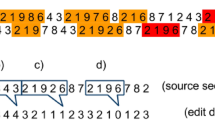Abstract
Creative thinking is often considered to be difficult, one reason because humans tend to be trapped in the same patterns of thinking and cannot easily come up with a totally new combination of concepts. In other words, humans are not talented at evenly exploring combinatorial space. In order to visualize how strong this tendency is, we implemented a system that asks the subject to type in a long sequence of numbers. The system then counts the frequency of the appearance of the same subsequences using n-grams. We called it “the Creativity Test.” It measures one’s efficiency of exploring a wider part of a combinatorial space without being caught in few patterns. The result is assumed to be related to the ability of divergent thinking, which is considered to be important in creative thinking. When we tested the system on a group of subjects, we discovered that, for most of them, surprisingly long n-grams appeared frequently, making the subjects realize how inefficient they were at coming up with new combinations.
Access this chapter
Tax calculation will be finalised at checkout
Purchases are for personal use only
Similar content being viewed by others
References
Altshuller, G.: Creativity as an Exact Science: The Theory of the Solution of Inventive Problems. Gordon and Breach Science Publishing, London (1984)
Amabile, T.M.: Creativity in Context: Update to the Social Psychology of Creativity. Westview Press, Boulder (1996)
Bostrom, R.P., Nagasundaram, M.: Research in Creativity and GSS, In: 31st Hawaii International Conference on System Sciences, pp. 391–405. IEEE Computer Society (1998)
Durand, D.E., VanHuss, S.H.: Creativity software and DSS: cautionary findings. Inf. Manag. 23, 1–6 (1992)
Duran-Novoa, R., Leon-Rovira, N., Aguayo-Tellez, H., Said, D.: Inventive problem solving based on dialectical negation, using evolutionary algorithms and TRIZ heuristics. Comput. Ind. 62, 437–445 (2011)
Guilford, J.P.: The Nature of Human Intelligence. McGraw-Hill Education, New York (1967)
Lopez-Ortega, O.: Computer-assisted creativity: emulation of cognitive processes on a multi-agent system. Exp. Syst. Appl. 40, 3459–3470 (2013)
Malaga, R.A.: The effect of stimulus modes and associative distance in individual creativity support systems. Decis. Support Syst. 29, 125–141 (2000)
Manning, C.D., Schutze, H.: Foundations of Statistical Natural Language Processing. The MIT Press, Cambridge (1999)
Massetti, B.: An empirical examination of the value of creativity support systems on idea generation. MIS Q. 20, 83–97 (1996)
Mednick, S.: The associative basis of the creative process. Psychol. Rev. 69(3), 220 (1962)
Muller-Wienbergen, F., Muller, O., Seidel, S., Becker, J.: Leaving the beaten tracks in creative work—a design theory for systems that support convergent and divergent thinking. J. Assoc. Inf. Syst. 12, 714–740 (2011)
Rhodes, M.: An analysis of creativity. The Phi Delta Kappan 42, 305–310 (1961)
Russ, S.W., Fiorelli, J.A.: Developmental approaches to creativity. In: Kaufman, J.C., Sternberg, R.B. (eds.) The Cambridge Handbook of Creativity, pp. 233–249. Cambridge University Press, Cambridge (2010)
Suchamn, L.: Plans and Situated Actions: The Problem of Human-machine Communication. Cambridge University Press, Cambridge (1987)
Seidel, S., Muller-Wienbergen, F., Becker, J.: The concept of creativity in the information systems discipline: past, present, and prospects. Commun. Assoc. Inf. Syst. 27, 14 (2010)
Sellen, A., Whittaker, S.: Beyond total capture: a constructive critique of lifelogging. Commun. ACM 53(5), 70–77 (2010)
Storm, B.C., Angello, G.: Overcoming fixation: creative problem solving and retrieval-induced forgetting. Psychol. Sci. 21(9), 1263–1265 (2010)
Tezuka, T., Yasumasa, S., Naghsh, F.A.: A system using n-grams for visualizing the human tendency to repeat the same patterns and the difficulty of divergent thinking. In: 8th International Conference on Knowledge, Information and Creativity Support Systems (2013)
Torrance, E.P.: The nature of creativity as manifest in its testing. In: Sternberg, R.J. (ed.) The Nature of Creativity: Contemporary Psychological Perspectives, pp. 43–75. Cambridge University Press, Cambridge (1988)
Acknowledgments
The work was supported in part by JSPS KAKENHI Grant Numbers 21700121, 25280110, and 25540159.
Author information
Authors and Affiliations
Corresponding author
Editor information
Editors and Affiliations
Rights and permissions
Copyright information
© 2016 Springer International Publishing Switzerland
About this paper
Cite this paper
Tezuka, T., Yasumasa, S., Naghsh, F.A. (2016). Visualization of N-Gram Input Patterns for Evaluating the Level of Divergent Thinking. In: Skulimowski, A., Kacprzyk, J. (eds) Knowledge, Information and Creativity Support Systems: Recent Trends, Advances and Solutions. Advances in Intelligent Systems and Computing, vol 364. Springer, Cham. https://doi.org/10.1007/978-3-319-19090-7_18
Download citation
DOI: https://doi.org/10.1007/978-3-319-19090-7_18
Published:
Publisher Name: Springer, Cham
Print ISBN: 978-3-319-19089-1
Online ISBN: 978-3-319-19090-7
eBook Packages: Computer ScienceComputer Science (R0)




